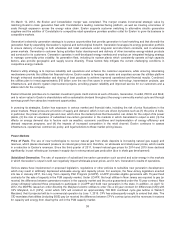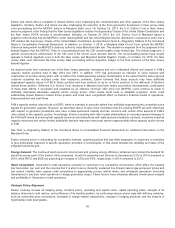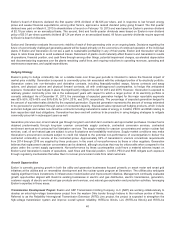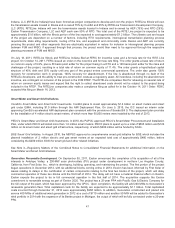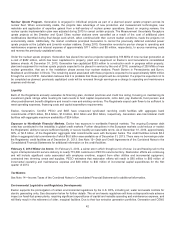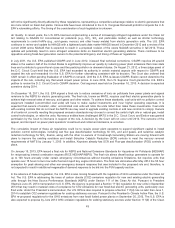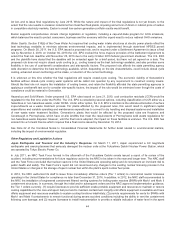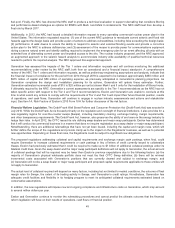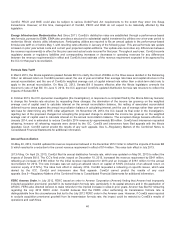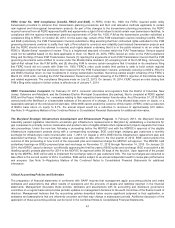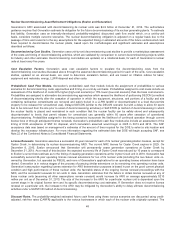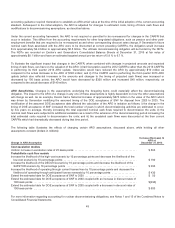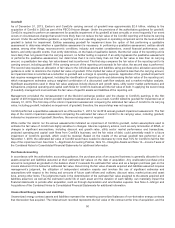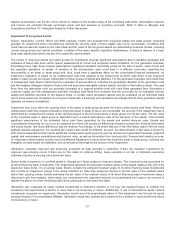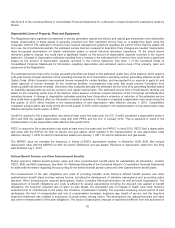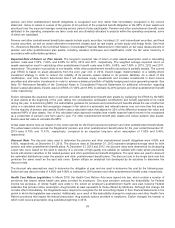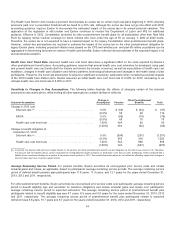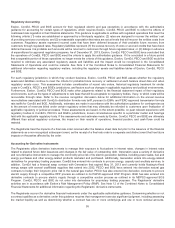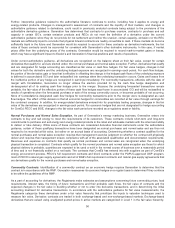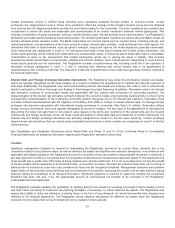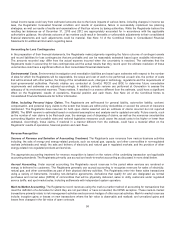ComEd 2013 Annual Report Download - page 54
Download and view the complete annual report
Please find page 54 of the 2013 ComEd annual report below. You can navigate through the pages in the report by either clicking on the pages listed below, or by using the keyword search tool below to find specific information within the annual report.Nuclear Decommissioning Asset Retirement Obligations (Exelon and Generation)
Generation’s AROassociatedwithdecommissioningitsnuclear unitswas $4.9 billion at December 31,2013.The authoritative
guidancerequiresthat Generation estimate itsobligation for thefuture decommissioningofitsnuclear generatingplants. Toestimate
that liability, Generation usesan internally-developed, probability-weighted, discountedcash flowmodel which, on a unit-by-unit
basis, considersmultiple outcomescenarios. Thenuclear decommissioningobligation is adjustedon a regular basis due to the
passageoftimeandrevisionsto thekeyassumptionsfor theexpectedtimingor estimatedamountsofthefuture undiscountedcash
flows requiredto decommission thenuclear plants, basedupon themethodologiesand significant estimatesandassumptions
describedasfollows:
Decommissioning Cost Studies. Generation usesunit-by-unitdecommissioningcoststudiesto provideamarketplaceassessment
ofthecostsandtimingofdecommissioningactivities, which are validatedbycomparison to current decommissioningprojectswithin
itsindustryandother estimates. Decommissioningcoststudiesare updated, on a rotational basis, for each ofGeneration’s nuclear
unitsat leastevery fiveyears.
Cost Escalation Factors. Generation usescostescalation factorsto escalate thedecommissioningcostsfromthe
decommissioningcoststudies discussedabovethrough theassumeddecommissioningperiodfor each oftheunits. Costescalation
studies, updatedon an annual basis, are usedto determine escalation factors, andare basedon inflation indicesfor labor,
equipment andmaterials, energy, LLRW disposal andother costs.
Probabilistic Cash Flow Models. Generation’s probabilistic cash flowmodelsincludetheassignment ofprobabilitiesto various
scenariosfor decommissioningcosts, approachesandtimingon a unit-by-unitbasis. Probabilitiesassignedto costlevelsincludean
assessment ofthelikelihoodofcosts20% higher (high-costscenario)or 15% lower (low-costscenario)than thebasecostscenario.
Probabilitiesare assignedto alternativedecommissioningapproaches which assess thelikelihoodofperforming DECON (amethod
ofdecommissioningshortlyafter thecessation ofoperation inwhich theequipment,structures, andportionsofafacilityandsite
containingradioactivecontaminantsare removedandsafelyburiedinaLLRWlandfill or decontaminatedto a level that permits
propertyto be releasedfor unrestricteduse), Delayed DECON (similar to theDECON scenariobut withadelayto allowfor spent
fuel to beremovedfromthesite prior to onset ofdecommissioningactivities) or SAFSTOR(amethodofdecommissioninginwhich
thenuclear facilityisplacedandmaintainedinsuch condition that thenuclear facilitycan besafelystoredandsubsequently
decontaminatedto levelsthat permit releasefor unrestrictedusegenerallywithin60yearsafter cessation ofoperations)
decommissioning. Probabilitiesassignedto thetimingscenariosincorporate thelikelihoodofcontinuedoperation through current
licenselivesor through anticipatedlicense renewals. Generation’s probabilistic cash flowmodelsalsoincludeanassessment ofthe
timingof DOE acceptanceof SNF for disposal, which Generation assumedwouldbeginin 2025in 2013 and2012.TheSNF
acceptancedate wasbasedon management’s estimatesoftheamount oftimerequiredfor theDOE to selectasite location and
develop thenecessaryinfrastructure.For more information regardingtheestimateddate that DOE will beginaccepting SNF, see
Note 22 oftheCombinedNotesto ConsolidatedFinancial Statements.
License Renewals. Generation assumesasuccessful 20-year renewal for each ofitsnuclear generatingstation licenses, except for
Oyster Creek, indeterminingitsnuclear decommissioningARO. Thecurrent NRClicensefor Oyster Creekexpiresin 2029. On
December 8, 2010,Exelon announcedthat Generation will permanentlyceasegeneration operationsat Oyster Creekby
December 31,2019. Asaresult ofthis decision theexpectedeconomic lifeof Oyster Creekwasreducedby10 yearsto correspond
to Exelon’s current bestestimate asto thetimingofceasinggeneration operationsat theOyster Creekunitin 2019. Generation has
successfullysecured20-year operatinglicense renewal extensionsfor ten ofitsnuclear units(includingthetwoSalemunitsco-
ownedbyGeneration,but operated by PSEG), andnone ofGeneration’s applicationsfor an operatinglicenseextension havebeen
denied. Generation is invariousstagesofthe process ofpursuing similar extensionson itsremainingnine operatingnuclear units.
Generation’s assumption regardinglicenseextension for AROdetermination purposesisbasedin part on thegoodcurrent physical
condition and high performanceofthesenuclear units; thefavorable statusoftheongoinglicense renewal proceedings withthe
NRC, andthesuccessful renewalsfor ten unitsto date.Generation estimatesthat thefailure to obtainlicense renewalsat anyof
thesenuclear units(assumingall other assumptionsremainconstant)wouldincreaseitsAROon average approximately$210
million per unitasofDecember 31,2013.ThesizeoftheincreasetotheAROfor a particular nuclear unitis dependent upon the
current stageinitsoriginal license termanditsspecific decommissioningcostestimates. If Generation doesnot receivelicense
renewal on a particular unit,theincreasetotheAROmaybemitigatedbyGeneration’s abilityto delayultimate decommissioning
activitiesunder a SAFSTORmethodofdecommissioning.
Discount Rates. The probability-weightedestimatedfuture cash flows usingthesevariousscenariosare discountedusingcredit-
adjusted, risk-free rates(CARFR)applicable to thevariousbusinessesinwhich each ofthenuclear unitsoriginallyoperated. The
48


